I started to read about Willards Old cemetery and how the flood of 1923 washed several of the graves out and deposited the remains to the West. The story has it that the men of town drove their “buckboards” and loaded up the remains and then they dug one large hole at the cemetery and put all the remains in and covered them up.
It was done because there was no way of knowing who’s bones were who’s.
But that’s not the reason for this posting. I got to thinking about the word “buckboard”. What does it mean?
My first thought was that the name derived because the men would go off hunting and come back with deer laying in the back of the wagon. Sort of like we do today, only not on top of the wagon, but in the back of it. So the boards of the wagon had bucks laying on them and thus the name. Buck boards.
We have all seen the cowboy shows and the guys are driving into and out of town with buckboard wagons full of sacks of whatever and of course the run away ones with the good looking chick trying to save her own life.
According to wikipedia, a buckboard wagon is truly a design made in America. Out of necessity, out fore fathers came up with the idea and put it all together. Probably without a seat and so they just knelt down and drove the horse and the load that way. But then somewhere along the way, the driver got kicked in the head by the horse and that wasn’t a pretty sight. So they added a slanted board in front of the driver. The slanted board was canted toward the horse and anchored with heavy metal brackets.
When they added seats to these wagons, that canted board became a place the driver and passengers could put their feet while they traveled. A very nice second use for the “buck board”.
You see, that canted board was called the “buck board” by the makers in order that the horses hind feet could not reach the drivers head in case it “bucked”.
There you have it…more knowledge for your pea brain.
Bears Butt
April 24, 2012


 Utah Fishing Reports
Utah Fishing Reports
Leave a Reply